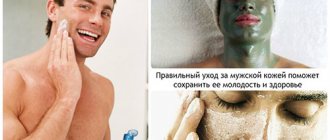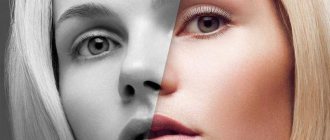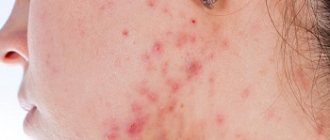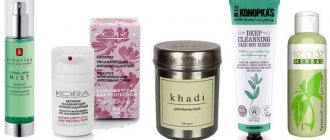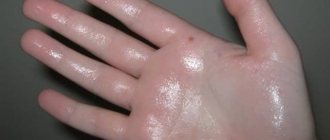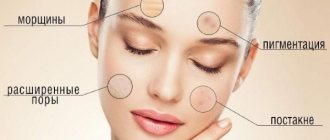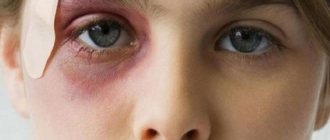Why does overactivity of the sebaceous glands occur?
Increased oil production from the sebaceous glands is a common problem encountered both during the transition period and throughout life. Experts attribute the disease to external and internal factors.
The most common causes of acne are internal causes:
- Hormonal disbalance. In adolescence, this is associated with puberty. In mature people, increased sebum secretion is associated with increased production of the male sex hormone – testosterone. The cause of the problem is polycystic disease or ovarian dysfunction. The hormone progesterone also affects skin problems.
- Genetic predisposition. If there are skin problems in parents or in the family, children are also likely to have increased activity of the sebaceous glands. Heredity is associated with congenital disorders in the functioning of the epithelium, deformation of the sebaceous glands, and excessive production of testosterone.
- Chronic diseases. Overactivity of the sebaceous glands indicates disturbances in the functioning of internal organs. Frequent causes are disruptions in the gastrointestinal tract, gastritis, dysbacteriosis, adrenal diseases, cholelithiasis, infectious inflammation in the body, and disorders of the autonomic system.
External causes include harmful environmental factors, as well as features of life and skin care:
- Cosmetic products. The wrong choice of basic skin care products leads to deterioration of the skin condition. Excessive use of products containing alcohol, oils, glycerin, and frequent scrubbing have a negative effect on the epidermis.
- Violation of hygiene rules. Improper skin care: infrequent or excessive cleansing, frequent use of nourishing products and scrubbing lead to a decrease in natural protection and disruption of the acid-base balance.
- Poor nutrition. An unbalanced diet, including foods containing fats, simple carbohydrates, and iodine, leads to digestive disorders, dysbiosis, and changes in skin condition. Lack of vitamins also provokes the development of skin diseases.
- Environmental impact. The work of the sebaceous glands is affected by external factors: frostbite, dry air in the room, frequent exposure to ultraviolet rays.
How to reduce fat formation on the face: traditional methods
Not only the pharmaceutical drug has a positive effect on the functioning of the sebaceous glands. At home, decoctions of medicinal herbs and recipes made from natural ingredients can restore the condition of the skin.
- Clay mask. The recipe uses grape puree and 2 teaspoons of clay (white, blue or pink). The ingredients are combined and applied to cleansed skin. Leave until completely dry, then remove with warm water.
- Decoction of medicinal herbs. A herbal decoction is prepared for daily use. Brew chamomile, calendula, and horsetail in a glass of water. Use the resulting decoction to wipe or rinse your face. Medicinal herbs relieve inflammation, improve complexion, and tighten pores. In addition to rinsing, the decoction is used to prepare ice cubes that are used to wipe the skin.
- Nettle compress. For preparation, use a tablespoon of dry nettle per glass of boiling water. The resulting decoction is infused for an hour. Then take clean gauze and soak it in nettles. The resulting compress is applied to the skin for 10 minutes.
- Starch mask. The recipe uses a tablespoon of potato starch, a teaspoon of lemon juice and 3 teaspoons of kefir. The ingredients are thoroughly mixed and applied to the skin for 15 minutes.
In addition to the recipes listed, oatmeal masks, tonics made from lime, lemon or cucumber juice help a lot. A preparation based on vitamin A or E is added to the natural ingredients.
General principles of treatment
Disruption of the sebaceous glands requires an integrated approach and an accurate determination of the cause that caused the development of the pathology.
Experts distinguish 3 degrees of severity of the problem:
- mild – expressed in increased skin shine and local appearance of acne;
- medium – expressed in clogged pores, acne formation, inflammation of skin areas;
- severe - the inflammatory process is clearly expressed, covering large areas of the skin.
Depending on the severity of the problem, treatment is prescribed. In most cases, it is enough to change the principles of skin care and competent selection of cosmetic products.
General therapy for disorders of the sebaceous glands is carried out in several areas:
- Comprehensive examination and treatment of chronic diseases. The patient needs to undergo an examination and identify existing disorders in the functioning of internal organs. Drug therapy is aimed at eliminating foci of inflammation, normalizing the functioning of the gastrointestinal tract, liver, kidneys, and improving the body's metabolic processes.
- Nutrition correction. The patient is advised to adhere to a proper diet. Fried and fatty foods, alcohol, carbonated drinks, and semi-finished products are completely excluded from it. Preference is given to fresh vegetables, fruits, and slow carbohydrates.
- Vitamin therapy. Vitamin complexes are added to the diet. Particular attention is paid to vitamins A, E, B, C, D.
- Skin care. To reduce the symptoms of inflammation, it is important to choose the right cosmetic products for basic care. It includes alcohol-free anti-inflammatory lotions, creams and gels with light textures. Matte products are used in decorative cosmetics.
- Drug therapy. Involves the use of drugs with antiseptic, antimicrobial, keratolytic or antibacterial effects.
Diet to normalize the functioning of the glands
Changing your diet is the first thing you need to do to reduce the activity of the sebaceous glands.
The following foods should be excluded from the diet:
- carbonated drinks;
- alcoholic products;
- fatty, fried, spicy;
- smoked and canned products;
- products containing dyes, flavors and flavor enhancers;
- bakery and confectionery products;
- strong coffee and black tea.
The following products should be present in larger quantities on the menu:
- fresh vegetables and fruits in season;
- dairy and fermented milk products;
- cottage cheese;
- lean meat;
- cereal porridge.
Eating red fish, sauerkraut, fresh herbs, and nuts has a positive effect on the condition of the skin. Recommended drinks include green tea, herbal infusions, and clean water.
How to get rid of sebaceous glands: drug treatment
Drug treatment is necessary in cases of moderate or severe disease. The selection of drugs is made only by a specialist, depending on the underlying reasons.
Drug therapy includes the following:
- use of local drugs;
- antibacterial treatment;
- normalization of hormonal levels.
Features of local therapy
Experts identify several groups of drugs that have shown high effectiveness when applied topically.
- Preparations with retinoic acid. The products help reduce the inflammatory process and normalize the functioning of the sebaceous glands. Adapalene is considered the optimal drug. The product is used once a day and has a cumulative effect. Requires long-term use.
- Antimicrobial drugs. Antimicrobial treatment is prescribed when papules and pustules appear. Proderm, Eclaran, Azelik, Skinoren, Zerkalin, Dalatsin are used as medications for topical use. The drugs are used 1-2 times a day.
- Combination drugs. The main advantage of this product line is an integrated approach and extended action. The composition includes several active components that can solve the problem. The most effective are Isotrexin, Klenzit, Zinerit.
Antibacterial therapy
In difficult cases, when the sebaceous glands malfunction, a bacterial infection may occur. In such situations, the use of antibacterial therapy is required.
According to research, bacteria have the least resistance to tetracycline antibiotics and macrolides. In case of purulent inflammations that provoke malfunctions of the sebaceous glands, Erythromycin, Josamycin, Dixycycline, Metacycline or Oxytetracycline are prescribed.
To relieve symptoms of hyperactivity of the sebaceous glands on the face, a full course of treatment is necessary, it lasts from 5 to 10 days. Antibacterial treatment must not be interrupted. The reason for stopping taking the drug may be individual intolerance to the active substance. The dosage and treatment regimen are prescribed only by a specialist.
Hormone therapy
Treatment of the sebaceous glands with hormonal therapy is possible only after laboratory tests and consultation with a gynecologist.
For therapy, drugs are selected to correct a woman’s hormonal levels. In most cases, these are hormonal contraceptives. They are produced in the form of tablets, rings, applicators, and implants. Correction with contraceptives is possible only if the woman does not expect to have children in the next six months.
If pregnancy is planned, cyclic hormone therapy is prescribed. It involves the use of estrogen at the beginning of the cycle and progesterone in the second half.
Effective pharmaceutical drugs
Pharmacy products are distinguished by a wide variety of both the principle of action and the price category.
When choosing cosmetics that improve the condition of your skin, experts recommend using products from the same series.
- La Roche-Posay. The company offers products to reduce the activity of the sebaceous glands. Currently a favorite among similar products. The main component is thermal water. The brand produces a wide range of products that improve the functioning of the sebaceous glands and reduce skin greasiness. Of these, there is a cleanser - Effaclar Gel and a special Effaclar mask for controlling sebum production and narrowing pores. The series also includes a product for skin toning, makeup removal and moisturizing.
- Avene. Another popular company that produces a wide range of products for oily skin. The most famous product is Cleanance gel. It is suitable for young acne-prone skin. In addition to it comes a sebum-regulating cream.
- Vichy. Well-known cosmetics for the care of problematic and oily skin. The company has released a separate line of products that restore the functioning of the sebaceous glands - Normaderm. It consists of a gel for washing, a mask, lotion, and day cream.
- Retinoic ointment. A drug for quick results. It is characterized by low cost. Apply to problem areas twice a day. Effective for acne and rashes, normalizes the functioning of the sebaceous glands. The course of application is no more than 1 week.
In the case of acne caused by clogged pores, Zinc, Salicylic ointment, Chlorhexidine, Salicylic-zinc paste, Aspirin tablets, vitamins A, E effectively help.
Salon methods for solving the problem
Increased secretion of the sebaceous glands can be treated using both cosmetic products and salon methods. They are prescribed when it is necessary to influence the deeper layers of the epidermis.
Salon procedures are prescribed after a comprehensive examination and are an effective addition to drug treatment.
Among the effective procedures, experts highlight the following:
- galvanization;
- microdermabrasion;
- laser resurfacing;
- mesotherapy;
- acid peeling;
- disincrustation.
A pronounced effect is observed only after a full course of procedures and subject to preventive skin care measures.
Scarring
Scars can appear on the skin as a result of injuries, burns, surgeries, or as a consequence of acne. Although not a disease in the full sense of the word, scars can nevertheless cause serious psychological discomfort.
It is customary to distinguish several types of scars:
- Hypotrophic
- scars that sink relative to the surface of the skin. Such scars occur after acne (post-acne), chickenpox or minor skin injuries. Striae (stretch marks) also belong to this type. - Normotrophic
- scars that are at the same level with the skin; they are not as noticeable on the surface of the skin as other types of scars; they arise as a result of shallow wounds and burns. - Hypertrophic
scars are dense scars that rise above the surface of the skin. Such scars are prone to peeling, itching and ulceration. They can appear as a result of: significant injuries, 3-4 degree burns, surgery, prolonged wound suppuration or injury to other types of scars (for example, normotrophic). More often, hypertrophic scars form in people with a genetic predisposition to the formation of this type of scars. - Keloids
are a special type of scar. Such scars are very raised above the skin, have a burgundy or bluish color and a dense structure, are often covered with tubercles, and can be painful when pressed. Irritation and itching often occur on their surface, leading to the formation of ulcers. This type of scar is characterized by growth beyond the original wound and recurrence after surgical excision. This is perhaps the most unfavorable outcome of skin damage. Genetic predisposition plays a major role in the occurrence of keloid scars.
The formation of a scar of any kind is the replacement of damaged skin with connective tissue. As a rule, the scar is completely formed within a year. Therefore, it is better to start treatment without waiting for the end of this process. However, in modern aesthetic medicine there are ways to correct old scars. The choice of treatment method depends on the age of the scar, its type, location and size.
In general, all methods of scar correction are divided into invasive (surgical excision) and non-invasive (physiotherapeutic). Invasive methods
involve surgical excision of scar tissue and the application of a cosmetic suture to form a new, invisible scar.
The excision of the scar itself can be done not only with a scalpel, but also with a laser, cold, and even medicinally - by injecting medication into the scar. Non-invasive methods
are effects that do not violate the integrity of tissues. Its main goal is to gradually transform a pathological scar into a normotrophic one, that is, one that is at the same level with the surface of the skin and is practically invisible. Non-invasive scar treatment methods are less traumatic and have a better prognosis.
MICRODERMABRASION
One of the most effective ways to remove scars. This method is especially relevant for the correction of “sinking” scars and scars that only slightly protrude above the surface of the skin. Using a special apparatus, a stream of solid crystals is directed onto the scar under high pressure. Very carefully, layer by layer of microparticles remove the scar. They do not damage the surrounding tissues, but provide a slight “shake” for the skin, due to which the synthesis of collagen fibers in the skin is activated, and its relief is smoothed. Gradually, the surface of the scars smoothes out, and the edges align with the surrounding skin. As a rule, to completely remove a scar or scar, it is necessary to undergo a course of procedures at intervals of 1-2 weeks.
For microdermabrasion, devices can also be used in which, instead of abrasive microparticles, nozzles with a diamond tip are used. Then the procedure becomes a little more traumatic, but also more effective.
With the advent of lasers in aesthetic medicine, new methods of treating scars have appeared. Modern laser technologies make it possible to permanently get rid of scars of any origin. Typically, scar removal is a complex procedure using different types of lasers.
LASER GRINDING
Formally, laser resurfacing is an invasive method, but modern lasers allow the doctor to act with pinpoint precision, so the procedure is very delicate, non-traumatic, and there is virtually no risk of side effects. The essence of this method is as follows: the laser delicately and with micron precision “cuts off” the scar tissue layer by layer. The main problem when performing such operations is the bleeding that inevitably occurs when the dermis is destroyed. But modern laser systems “seal” the vessels, preventing bleeding. Under the influence of a laser beam, the synthesis of collagen, the “building material” for skin renewal, is triggered and new smooth skin is formed. In addition, laser radiation has a bactericidal effect, which eliminates the risk of infection and complications. Laser resurfacing allows for the correction of all types of scars, primarily hypertrophic, normotrophic and atrophic, which is not possible with any other method of scar treatment.
CHEMICAL PEELING
A course of peeling with fruit acids can reduce the density of the scar and smooth its surface, turning a hypertrophic scar into an almost invisible normotrophic one.
MESOTHERAPY
Intradermal administration of biologically active and medicinal drugs is one of the main procedures for removing stretch marks and scars. Due to specially selected ingredients of the mesotherapy cocktail, it is possible to significantly reduce the density of the scar and even it out with the surface of the skin. In addition, mesotherapy triggers skin cell regeneration processes, stimulates collagen synthesis and restores the aesthetic appearance of the skin. The skin becomes healthy, elastic, and toned. Using the mesotherapy method, you can correct all types of scars, except keloids.
Scar correction can be a lengthy process, but the best results come from an integrated approach to treatment.
Created 02 Sep 2012
Proper care for oily skin
When caring for oily skin, which is often classified as problematic, it is important to follow a step-by-step strategy and not skip steps. So
Removing Makeup Typically, oily skin is prone to acne. To prevent them, thoroughly remove cosmetics from your face - for example, using hydrophilic oil or micellar water.
Washing Use cleansing foams or gels to remove remnants of cosmetics and makeup removers from the skin.
Important! Even with oily skin, cleansing should not be aggressive: the more you dry the epidermis, the more sebum it secretes. So no alcohol-containing formulas.
Toning Tonics are the most underrated product in skin care, but no less a must-have.
Toning helps complete the cleansing process, restore the pH level and hydrolipid mantle after washing with gel or foam.
Exfoliation Mechanical or chemical exfoliation helps remove (in the second case, dissolve) dead epidermal cells. And this, in turn, makes it easier for sebum to freely come to the surface of the skin and not accumulate in the pores.
Moisturizing Many people with oily skin neglect moisturizing, mistakenly believing that they do not need it - it would be better to get rid of excess shine. But the truth is that oily skin can suffer from a severe lack of moisture and is prone to dehydration.
Nutrition Even oily skin can suffer from cold and icy winds in winter. To prevent weather conditions from damaging the hydrolipidic barrier, before going outside, protect your skin with a nourishing cream without comedogenic components.
Deep cleansing Cleansing masks based on absorbents (clay, activated carbon) help remove excess oil and prevent the growth of bacteria in the pores.
Clay masks should be used no more than twice a week and under no circumstances should they be allowed to dry out to the point of cracking - when they harden, they can lead to tightness of the skin.
Folk remedies
1. A decoction of oak bark is suitable for oily seborrhea.
Finely chop the oak bark, pour boiling water over it in a ratio of 1:5, boil for 20 minutes, leave for half an hour, strain. Then add honey to the resulting decoction (1 teaspoon per glass of decoction). Stir thoroughly and rub into hair roots.
2. You will need the following medicinal herbs: nettle, burdock root, St. John's wort, plantain leaves, immortelle (flowers), calendula flowers and corn columns with stigmas. Mix all herbs in equal proportions. Take 2 tbsp. spoons of the resulting mixture, pour 200 ml of boiling water over them, boil for 20 minutes in a water bath, leave for 30 minutes, strain.
Rub the resulting decoction into the scalp (the hair must be clean before the procedure). Place a plastic bag on your head, leave it there for half an hour, then remove it. Don't wash your hair!
- St. John's wort grass, burdock roots, corn columns with stigmas, string grass, chamomile (flowers), immortelle flowers, tansy. Everything in equal quantities.
- for oily skin: 3 parts chamomile flowers, 3 parts crushed burdock roots, 3 parts St. John's wort, 7 parts nettle leaves. In the article about oily and problem skin, you can learn about other means of combating this scourge. Follow the link.
3. Decoction of onion peels.
Rinse two tablespoons of onion peel, then pour in 2 cups of boiling water, boil for 15 minutes over low heat, leave for 30 minutes, strain. Wet dry, clean hair with this decoction and let it air dry.
We suggest you read: Why doesn't pubic hair grow? And what to do if it’s bad and slow

